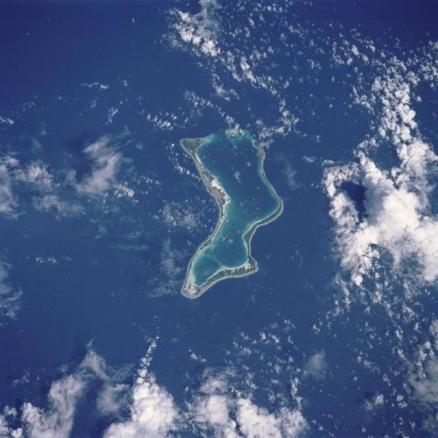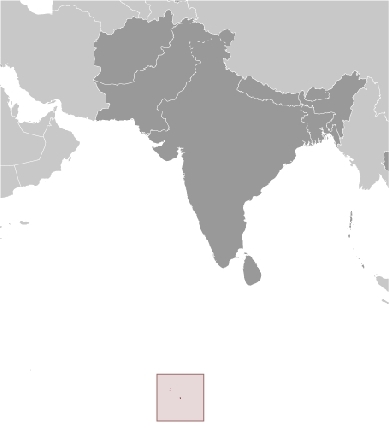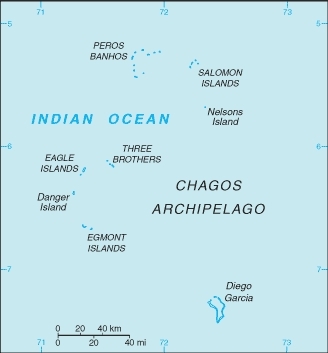British Indian Ocean Territory
| Topics: |
Countries and Regions of the World Collection  The British Indian Ocean Territory (BIOT) is an archipelago 55 islands in the Indian Ocean, south of India, about halfway between Africa and Indonesia.
The British Indian Ocean Territory (BIOT) is an archipelago 55 islands in the Indian Ocean, south of India, about halfway between Africa and Indonesia.
Diego Garcia, the largest and southernmost island, occupies strategic location in central Indian Ocean and is the site of joint United States-United Kingdom military facility.
Diego Garcia is approximately 560 km (350 mi) south of the Maldive Islands in the central Indian Ocean. The crescent shape of the coral island encloses a lagoon that forms the harbor. Diego Garcia is the site of a large Anglo-American Naval Air and Communications facility located on the northwest part of the atoll. All of the remaining islands are uninhabited.
The British Indian Ocean Territory has no indigenous inhabitants. However, approximately 1,200 former agricultural workers resident in the Chagos Archipelago, often referred to as Chagossians or Ilois, were relocated to Mauritius and the Seychelles in the 1960s and 1970s; in November 2004, approximately 4,000 UK and US military personnel and civilian contractors were living on the island of Diego Garcia
Formerly administered as part of the British Crown Colony of Mauritius, the British Indian Ocean Territory (BIOT) was established as an overseas territory of the UK in 1965.
A number of the islands of the territory were later transferred to the Seychelles when it attained independence in 1976. Subsequently, BIOT has consisted only of the six main island groups comprising the Chagos Archipelago.
Between 1967 and 1973, former agricultural workers, earlier residents in the islands, were relocated primarily to Mauritius, but also to the Seychelles. Negotiations between 1971 and 1982 resulted in the establishment of a trust fund by the British Government as compensation for the displaced islanders, known as Chagossians. Beginning in 1998, the islanders pursued a series of lawsuits against the British Government seeking further compensation and the right to return to the territory. In 2006 and 2007, British court rulings invalidated the immigration policies contained in the 2004 BIOT Constitution Order that had excluded the islanders from the archipelago, but upheld the special military status of Diego Garcia. In 2008, the House of Lords, as the final court of appeal in the UK, ruled in favor of the British Government by overturning the lower court rulings and finding no right of return for the Chagossians.
The British Indian Ocean Territory is overseas territory of the UK; administered by a commissioner, resident in the Foreign and Commonwealth Office in London.
Mauritius and Seychelles claim the Chagos Islands.
The United Kingdom created the world's largest marine protection area around the Chagos islands prohibiting the extraction of any natural resources therein
All economic activity is concentrated on Diego Garcia, where the joint UK-US military facility is located. Construction projects and various services needed to support the military installation are performed by military and contract employees from the UK, Mauritius, the Philippines, and the US. There are no industrial or agricultural activities on the islands. The territory earns foreign exchange by selling fishing licenses and postage stamps.
Location: archipelago in the Indian Ocean, south of India, about halfway between Africa and Indonesia
Geographic Coordinates: 6 00 S, 71 30 E; note - Diego Garcia 7 20 S, 72 25 E
Area: 54,400 sq km - land: 60 sq km; Diego Garcia 44 sq km; water: 54,340 sq km. Note: this includes the entire Chagos Archipelago of 55 islands.
Coastline: 698 km
Maritime Claims:
Terrain: flat and low (most areas do not exceed two meters in elevation). The highest point is an unnamed location on Diego Garcia (15 m).
Climate: Tropical marine; hot, humid, moderated by trade winds. The climate of this archipelago is monsoon tropical, with a dry season associated with the winter northeast monsoon lasting December to March and the rainy season of the southwest monsoon from April to October. Annual rainfall varies from lows around 1,600 millimeters (mm) in the drier Lakshadweep Islands, to highs over 3,800 mm in parts of the southern Maldives. Temperatures vary little this close to the equator, generally ranging between 24°C and 30°C. Humidity is usually high, though constant breezes are present to stir the air. Monsoons can be severe, occasionally causing tidal waves capable of uprooting large trees, flooding arable land with seawater, and destroying houses and piers.
Natural Resources: coconuts, fish, sugarcane
Ecology:
The Maldives-Lakshadweep-Chagos Archipelago tropical moist forests ecoregion is an unusual sight viewed from the air. In this region of the Indian Ocean, many thin ring-shaped atolls stand out against blue ocean with their extensive reef system visibly spreading offshore. While it is this reef system that receives the majority of attention from the conservation community, the terrestrial portion of this system of thousands of islands serves as important habitat for several species. Many of the islands are major seabird rookeries and are also important turtle nesting areas. Two fruit bats and a few butterflies are endemic to the archipelago. Once covered in tropical rain forest, almost all native vegetation has been cleared.
Maldives, Lakshadweep and Chagos are three island groups in the Indian Ocean that together form a vast submarine mountain range, the Chagos-Laccadive Plateau. This volcanic range lies just east of the Mid-Indian Ridge and west of the Mid-Indian Basin. The Vema Fracture Zone lies underwater to the southeast of Chagos. The chain of islands are aligned north to south between 72°-74° E. Altogether, the Maldives-Lakshadweep-Chagos Archipelago comprises the most extensive coral reef and atoll community in the Indian Ocean as well as the largest atoll system in the world.
The Chagos Archipelago has the largest expanse of undisturbed reefs in the Indian Ocean, as well as some of the most diverse. In addition to five atolls, including the Great Chagos Bank, the world's largest atoll in terms of area, there are two areas of raised reef and several large submerged reefs. There are no ancient rocks in the archipelago’s current geological structure. Exposed coral rock erodes into white coral sand that is shallow, alkaline, nutrient-poor, and that has low water retaining capacity. Generally, freshwater occurs about 1-3 m beneath the surface, floating above salt water. Though some of the islands have small lakes, fresh water can be a scarce resource.
The natural vegetation of the Maldives-Lakshadweep-Chagos Islands with substantial enough soil is tropical rain forest. Islands with poorer soil support a shrub cover of hardy salt and drought resistant bushes and Cyperaceae species. However, very little of this native ecosystem remains undisturbed. Littoral trees were once prominent; now scattered remnants of the original vegetation are found on some islands. For example, stands of the shrub Scaevola and the treelet Argusia can be found at Lakshadweep. Chagos may be the least disturbed group, supporting broadleaved woodland of Ficus, Morinda and Terminalia (especially on smaller islands), Casuarina woodland, mixed coconut woodland, Scaevola scrub, and marsh communities. Many species have been introduced and are naturalized; coconut is cultivated extensively along with other fruit trees where viable.
Rao and Shastry classified the vegetation of the Lakshadweep Islands as Strand Coral. This includes an open pioneer zone, woodland zone, and coastal zone, each with a dominant tree or plant. Again, little of the original vegetation is left, as much of the land is cultivated for coconuts. One tract of the native mangrove Bruguiera parviflora remains on Mincoy Island, covering only 2,500 meters squared (m2). Neither flora nor fauna of these islands has any significant endemism. Rather, the vegetation is typical of Indo-Pacific coral island flora. The plants present are primarily of pantropical or cosmopolitan distribution, the main components being Sri Lankan (44%), African (28%), Malaysian (25%), and the remainder from distinct coral habitats.
Biodiversity Features
Terrestrial animals are limited on these islands, and most species are not unique but are widely distributed throughout other oceanic Indo-Pacific atolls. The only native mammals on the islands are two species of fruit bat, Indian flying fox (Pteropus giganteus ariel) and a subspecies of variable flying fox (Pteropus hypomelanus maris). Both are of conservation concern; the latter is quite rare with only a few recordings. Important marine mammals are short-beaked saddleback dolphin (Delphinus delphis) and a subspecies of Cuvier’s beaked whale (Ziphius cavirostris indicus).
The islands are particularly important for resident and breeding birds. Birds of special concern include an endemic subspecies, the Maldivian pond heron (Ardeola grayii phillipsi), white tern (Gygis alba monte), lesser frigate (Fregata ariel iredalei), black-naped tern (Sterna sumatrana), brown-winged tern (S. anaethetus), and large-crested tern (S. bergi). Thirteen to fourteen seabirds are known to nest on Maldives, and large rookeries are also present on Chagos and Lakshadweep. Important populations of red-footed booby (Sula sula) inhabit Chagos.
The Maldives and Chagos islands are important nesting sites for the endangered green turtle (Chelonia mydas). Other sea turtles likely using the islands are the Olive Ridley turtle (Lepidochelys olivacea), leatherback turtle (Dermochelys coriancea), loggerhead turtle (Caretta caretta gigas), and hawksbill turtle (Eretmochelys ambricata). Reptiles and amphibians recorded from the islands include 2 geckoes (Hemidactylus spp.), 2 agamid lizards including the common garden lizard or blood sucker (Calotes versicolar), the snake skink (Riopa albopunktata), common wolf snake (Lycodon aulicus), another snake, Typhlos braminus, a short-headed frog, Rana breviceps, and a larger toad, Bufo melanostictus. Many invertebrates are recorded from the islands, including two endemic butterflies, Hypolimnas bolina euphorioides and Junonia villida chagoensis.


